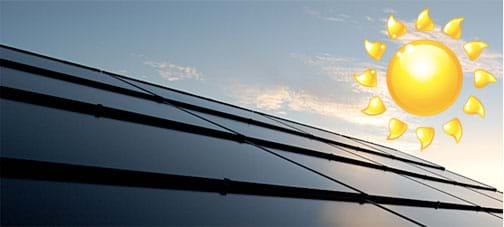
Summary
Through a series of four lessons, students are introduced to many factors that affect the power output of photovoltaic (PV) solar panels. Factors such as the angle of the sun, panel temperature, specific circuit characteristics, and reflected radiation determine the efficiency of solar panels. These four lessons are paired with hands-on activities in which students design, build and test small photovoltaic systems. Students collect their own data, and examine different variables to determine their effects on the efficiency of PV panels to generate electrical power.Engineering Connection
To design a long-lasting, safe and efficient photovoltaic system, engineers take into account many factors that affect power generation. Trade-offs are involved in every efficiency measure, and the best designs accommodate specific environmental and economic conditions. To design optimal PV systems, engineers account for all these factors and how they interact.
Unit Overview
In lesson 1, students study the solar angles involved in maximizing PV power generation. In lesson 2, panel temperature is compared with power output. Lesson 3 deals with balancing voltage and current output to create the largest power output (using Ohm's law and the electrical power equation [power = voltage x current]). In lesson 4, students examine the effect of concentrating solar radiation on PV panels.
The four activities use mini PV panels, multimeters and 100-watt lamps—items that are re-usable for all activities. Refer to the attached Solar Panel Source Information and Multimeter Source Information.
Educational Standards
Each TeachEngineering lesson or activity is correlated to one or more K-12 science,
technology, engineering or math (STEM) educational standards.
All 100,000+ K-12 STEM standards covered in TeachEngineering are collected, maintained and packaged by the Achievement Standards Network (ASN),
a project of D2L (www.achievementstandards.org).
In the ASN, standards are hierarchically structured: first by source; e.g., by state; within source by type; e.g., science or mathematics;
within type by subtype, then by grade, etc.
Each TeachEngineering lesson or activity is correlated to one or more K-12 science, technology, engineering or math (STEM) educational standards.
All 100,000+ K-12 STEM standards covered in TeachEngineering are collected, maintained and packaged by the Achievement Standards Network (ASN), a project of D2L (www.achievementstandards.org).
In the ASN, standards are hierarchically structured: first by source; e.g., by state; within source by type; e.g., science or mathematics; within type by subtype, then by grade, etc.
See individual lessons and activities for standards alignment.
Subscribe
Get the inside scoop on all things TeachEngineering such as new site features, curriculum updates, video releases, and more by signing up for our newsletter!Unit Schedule
- Day 1: Solar Angles and Tracking Systems lesson
- Day 2: A New Angle on Photovoltaic Solar Panel Efficiency activity
- Day 3: The Temperature Effect lesson
- Day 4: Photovoltaics & Temperature: Ice, Ice, PV! activity
- Day 5: Maximum Power Point lesson
- Day 6: Pointing at Maximum Power for PV activity
- Day 7: Concentrated Solar Power lesson
- Day 8-11: Concentrating on the Sun with Photovoltaic Solar Panels activity
Worksheets and Attachments
Visit [www.teachengineering.org/curricularunits/view/cub_pveff_curricularunit] to print or download.More Curriculum Like This

Students learn about the daily and annual cycles of solar angles used in power calculations to maximize photovoltaic power generation. They gain an overview of solar tracking systems that improve PV panel efficiency by following the sun through the sky.

Students learn how to find the maximum power point (MPP) of a photovoltaic (PV) panel in order to optimize its efficiency at creating solar power. They also learn about real-world applications and technologies that use this technique, as well as Ohm's law and the power equation, which govern a PV pa...

Students explore how the efficiency of a solar photovoltaic (PV) panel is affected by the ambient temperature. They learn how engineers predict the power output of a PV panel at different temperatures and examine some real-world engineering applications used to control the temperature of PV panels.

Students learn how the total solar irradiance hitting a photovoltaic (PV) panel can be increased through the use of a concentrating device, such as a reflector or lens.
Assessment
Pre/Post Unit Quiz: To conduct an overall pre/post assessment of the unit and gauge student learning, administer the eight-question Solar Quiz to students before beginning any discussion on photovoltaic solar panels. After unit completion, administer the same quiz to the same students and compare pre- to post- scores.
Copyright
© 2009 by Regents of the University of ColoradoContributors
William Surles, Abby Watrous, Jack Baum, Stephen Johnson, Eszter Horyani, Dr. Gregor Henze, Malinda Schaefer Zarske, Denise W. CarlsonSupporting Program
Integrated Teaching and Learning Program, College of Engineering and Applied Science, University of Colorado BoulderAcknowledgements
This high school curriculum was originally created as a class project by engineering students in a Building Systems Program course at CU-Boulder.
The contents of these digital library curricula were developed by the Integrated Teaching and Learning Program under National Science Foundation GK-12 grant no. 0338326. However, these contents do not necessarily represent the policies of the National Science Foundation, and you should not assume endorsement by the federal government.
Last modified: February 1, 2018







User Comments & Tips